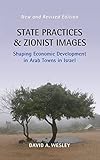State Practices and Zionist Images : Shaping Economic Development in Arab Towns in Israel / David A. Wesley.
Material type: TextPublisher: New York ; Oxford : Berghahn Books, [2013]Copyright date: ©2013Description: 1 online resource (276 p.)Content type:
TextPublisher: New York ; Oxford : Berghahn Books, [2013]Copyright date: ©2013Description: 1 online resource (276 p.)Content type: - 9781800735446
- 9780857459077
- Bureaucracy -- Israel -- Case studies
- Palestinian Arabs -- Israel -- Economic conditions -- Case studies
- Power (Social sciences) -- Israel -- Case studies
- Social integration -- Israel -- Case studies
- Social planning -- Israel -- Case studies
- SOCIAL SCIENCE / Anthropology / General
- Anthropology (General), Political and Economic Anthropology
- 338.9569400917/4927 22
- online - DeGruyter
| Item type | Current library | Call number | URL | Status | Notes | Barcode | |
|---|---|---|---|---|---|---|---|
 eBook
eBook
|
Biblioteca "Angelicum" Pont. Univ. S.Tommaso d'Aquino Nuvola online | online - DeGruyter (Browse shelf(Opens below)) | Online access | Not for loan (Accesso limitato) | Accesso per gli utenti autorizzati / Access for authorized users | (dgr)9780857459077 |
Browsing Biblioteca "Angelicum" Pont. Univ. S.Tommaso d'Aquino shelves, Shelving location: Nuvola online Close shelf browser (Hides shelf browser)
Frontmatter -- Contents -- List of Illustrations -- List of Tables -- Foreword -- Acknowledgments -- Abbreviations -- Introduction: An Ethnography of Macro-order Power Relations -- 1 The Lay of the Land (I): The Territorial Demon -- 2 The Lay of the Land (II): Urban Drive and the Arab Towns -- 3 The Zipporit Industrial Area -- 4 Land, Territory, and Jurisdiction: The Experience of Land Loss -- 5 The Image of Arab Traditionalism -- 6 The Appropriation of Arab Development Needs and Potential -- 7 Attempts to Break Through the Boundaries -- Conclusion -- Epilogue to the New Edition -- Chronology of Events -- Notes -- Glossary: Locality and Related Terms -- References -- Legislation Cited -- Subject Index -- Selected Author Index
restricted access online access with authorization star
http://purl.org/coar/access_right/c_16ec
Although the Israeli state subscribes to the principles of administrative fairness and equality for Jews and Arabs before the law, the reality looks very different. Focusing on Arab land loss inside Israel proper and the struggle over development resources, this study explores the interaction between Arab local authorities, their Jewish neighbors, and the agencies of the national government in regard to developing local and regional industrial areas. The author avoids reduction to simple models of binary domination, revealing instead a complex, multi-dimensional field of relations and ever-shifting lines of political maneuver and confrontation. He examines the prevailing concept of ethnic traditionalism and argues that the image of Arab traditionalism erects imaginary boundaries around the Arab localities, making government incursion disappear from view, while underpinning and rationalizing the exclusion of the Arab towns from development planning. Moreover, he shows how images of environmental protection mesh with and support such exclusion. The study includes a chronology of events, tables, maps, and photographs. This revised paperback edition with a new epilogue brings accounts of Arab land loss and struggles for economic development up to date. The author also deals with the challenges of life and research in Israel and examines the possibilities of sharing the land as the homeland of both Jews and Palestinians.
Mode of access: Internet via World Wide Web.
In English.
Description based on online resource; title from PDF title page (publisher's Web site, viewed 25. Jun 2024)









